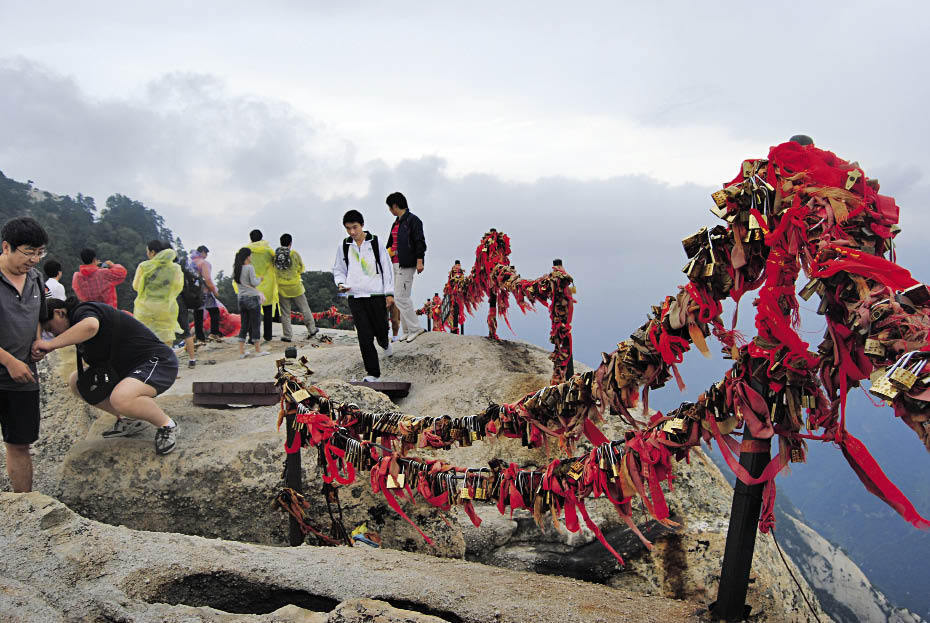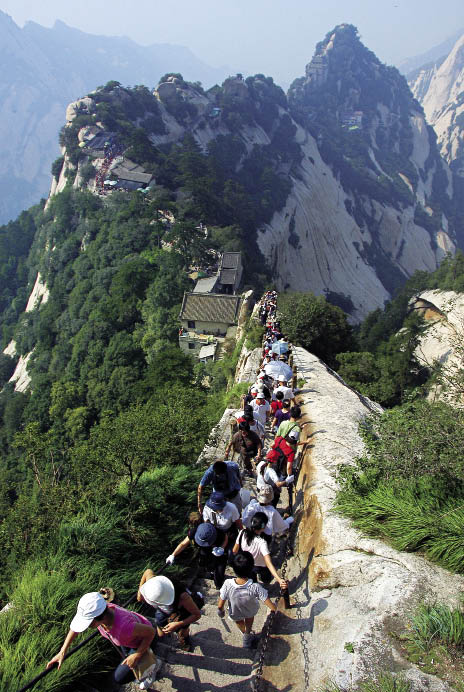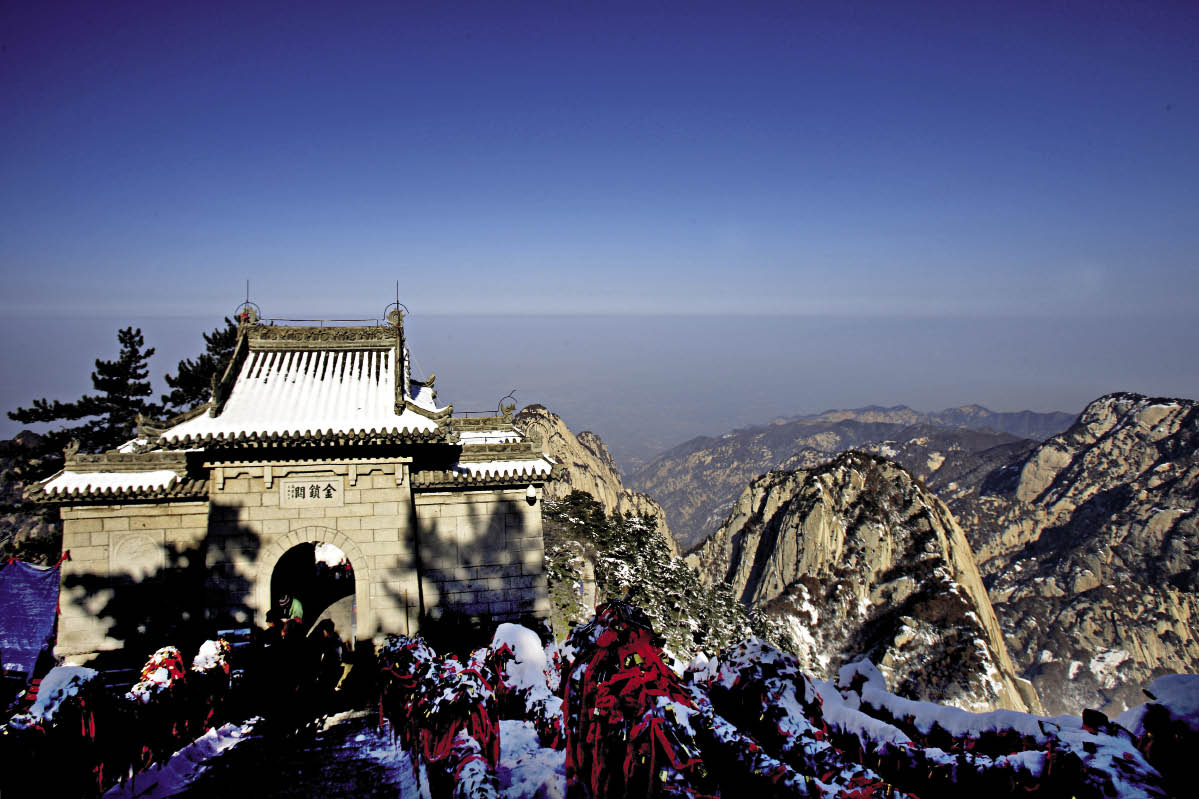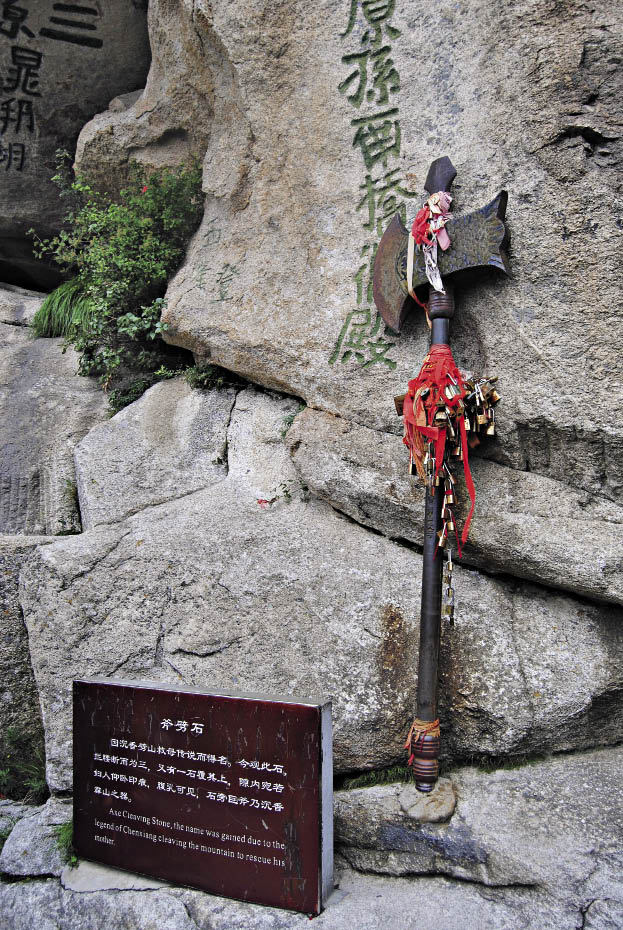Mount Hua -- Most Precipitous Mountain under Heaven
By staff reporter DANG XIAOFEI
MOUNT Hua (Huashan) in Huayin City, Shaanxi Province, is one of China’s Big Five mountains, the others being Mount Tai in Shandong Province, Mount Heng in Shanxi Province, Mount Song in Henan Province, and Mount Heng (another character in Chinese) in Hunan Province.
Although its highest peak stands just 2,100 meters tall, Mount Hua is nonetheless known as the “most precipitous mountain under heaven,” and one of the 50 most popular scenic spots among overseas visitors to China.
Site of 210 natural and cultural scenic spots, it is often referred to as the “root of Chinese civilization.” Mount Hua also has strong Taoist connotations – many prominent figures associated with this indigenous religional-philosophical tradition of China had presence in the area.
|
 |
| It’s a time-honored tradition for lovers to hang “One Heart” locks on the safety chain flanking the steps up Mount Hua. |
Sheer Precipices
Although Mount Hua has two cable car lines, visitors are advised to climb the mountain on foot. Most of its scenic spots can be seen along the popular Huashanyu (Huashan Gorge) hiking trail, an expansion of the path that was for millennia the sole trail up the mountain.
Mount Hua is distinct in China, where most mountains are of limestone, in consisting of a huge body of granite, formed during the cretaceous period over 100 million years ago. It extends 15 kilometers from east to west and 10 kilometers from south to north. As a fault-block mountain, Mount Hua features precipitous cliffs that present a challenge even to experienced mountaineers.
Mount Hua is renowned for its steep trails, particularly the one-foot-wide Changkong plank path on the south peak comprising three narrow wooden boards affixed to the cliff by steel rods. Climbers make their way along it facing the cliff with the help of an iron chain similarly attached to the cliff face. Known as Mount Hua’s most dangerous trail, climbers are required to wear safety belts that enable them to enjoy the breathtaking view without fear of falling.
Yaozi Fanshen is another perilous trek. Yaozi means sparrow hawk and fanshen rolling over. The trek is so named because at some points climbers must turn their bodies when climbing down, in the manner of flying sparrow hawks. Visually, the Yaozi Fanshen trek is less daunting than the Changkong plank path. But it is more difficult due to the overhanging upper part of the cliff and indented lower part, which makes it impossible to see the footholds – grooves chiseled into the slippery rock face – below. A single iron chain is the sole safety measure. Climbers must consequently concentrate all their attention on finding handholds and footholds as they make their careful descent down the path.
There are three more steep sections between the Taoist shrine Yuquanyuan and the Northern Peak – namely Qianchichuang (thousand-foot stela), Baichixia (hundred-foot gorge) and Laojun Ligou (Laojun furrow). Qianchichuang is a crevasse between two huge rocks. The trek is on a 70 degree angle slope and consists of 370-odd steps, each extremely narrow. Climbers proceed with the help of iron chains along both sides of the rock walls. As the crack goes deep between the rocks, only a ribbon of sky is visible when looking up.
Baichixia is a section of stone steps between two escarpments, between which hangs a huge monolith named Heart-quake Stone that appears to be falling from the skies. It gives access to scenic spots such as the Immortal Bridge and Black Tiger Ridge.
The deep, dangerous Laojun Ligou climb comprises 570 or more steps, hidden amid steep cliffs. Legend has it that Taoist immortal Taishang Laojun, or Supreme Lord, found his way there but could not get out, and so had his ox build the trekking trail through the night.
Because of a light rain, which makes climbing even more perilous, I took the western cable car line to the West Peak, whose huge stones resemble a lotus. The West Peak is connected to the South Peak by the dragon-shaped Quling Range – another highly challenging climbing route.

The perilous Feiyu (Flying Fish) Ridge.
Rich Cultural Heritage
As it was raining when we climbed Mount Hua we decided for safety’s sake not to brave the steep treks. But we made the most of the mountain’s cultural sites. The main reason why Mount Hua is one of China’s Big Five mountains is the bond it represents with Chinese history and culture.
Mount Hua is one of the cradles of Chinese culture. Certain archaeologists and contemporary scholars believe that terms such as Zhonghua, Huaxia (both meaning China in a cultural sense), and Huaren (meaning Chinese people) all derive from the name of Mount Hua, because they contain the Chinese character hua.
Historical documents show that many celebrated personages have left their footprints on the mountain. More than 4,000 years ago, the Yellow Emperor and sagely kings Yao and Shun all offered sacrifices to Mount Hua. Rulers of the Xia, Shang and Zhou dynasties of 3,000 years ago would pray on Mount Hua every year. After Qinshihuang, first emperor of a unified China, instituted the ceremony honoring Mount Hua, emperors of succeeding dynasties over the course of 2,000 or more years conducted large-scale ceremonies paying homage to the mountain. Eminent rulers such as Emperor Wudi (156-87 BC) of the Han Dynasty, Empress Wu Zetian (624-705) and Emperor Xuanzong (685-762) of the Tang Dynasty and Emperor Qianlong (1711-1799) of the Qing Dynasty all went to Mount Hua to offer sacrifice.
Since the Sui (581-618) and Tang (618-907) dynasties, famous men of letters in Chinese history such as Du Fu and Li Bai have written 1,000 or more poems, articles and travelogues dedicated to Mount Hua. On our climb we saw many inscriptions on cliff faces and stones that give insight into the development of Chinese characters, and styles of calligraphy denoting different periods.
Mount Hua is one of the birthplaces of Taoism. Taoist sages such as Chen Tuan (871-989) and Hao Datong (1149-1212) reportedly went on retreats to hermitages on the mountain. It is also site of 72 caves used for meditation and 20 or more Taoist temples. Among them, Yuquanyuan, or Cloister of Jade Spring, built between 1049 and 1051 during the Song Dynasty, is a famous Taoist temple of the Quanzhen School, built by Taoist priest Jia De-sheng for his master Chen Tuan. Upon entering the temple we came to a yard surrounded by circular corridors lined with ancient trees towering to the sky. Yuquanyuan offers visitors a tranquil place to rest. The daily lectures it holds on Taoism and self-cultivation also acquaint them with the fundaments of Taoist culture.

Jinsuo (Gold Lock) Pass.
Martial Arts and Chivalry
Mere mention of Mount Hua calls for an explanation of its connection with the spirit of Chinese martial arts. As Mount Hua is adjacent to the Yellow River it can be considered the cradle of the Chinese civilization. Having experienced joys and woes throughout history, the Chinese people have cultivated an unbending spirit when facing difficulty. Mount Hua’s precipitous features embody such courage and fortitude. Louis Cha Leung-yung is a famous exponent of martial arts and chivalric novelist, better known in China by his pen name Jin Yong. He expresses appreciation of the supernatural ambience of Mount Hua through making it the location of the foremost martial arts competition as featured in one of his novels.
Having been a fan of Jin Yong’s novels since childhood, I longed to visit Mount Hua and see the scenery he describes. Many people, like me, know about Mount Hua purely through Jin Yong’s books. He thought up the Chinese idiom Hua Shan Lun Jian, meaning swords meet on Mount Hua. It refers to the tradition where martial arts practitioners come to Mount Hua to test their martial arts prowess and endeavor to become the first under heaven. Today the idiom is widely used as a metaphor for open competition.
Relying on historical materials, artistic imagination and creativity, Jin Yong described Mount Hua in 13 of his 15 novels. It is the backdrop to classic works of his such as The Legend of the Condor Heroes, The Return of the Condor Heroes, The Smiling, and Proud Wanderer. Jin Yong perceives precipitous Mount Hua as embodying a sacred world of immortals, and hence as an ideal backdrop to his stories.
Ironically enough, Jin Yong did not actually visit Mount Hua until 2003. It was only then that he laid eyes on the place he has so often described.

The Axe Cleaving Stone.
Charming Throughout the Year
Mount Hua scenery celebrates the best of all four seasons. In spring it abounds in peach blossoms and other wild flowers. The weather is cool and pleasant in summer – a good time for visitors to see glorious sunrises and sunsets as well as waterfalls. Autumn is the perfect temperate season for photo-graphy and mountain climbing. In winter, visitors can enjoy a vista of snow-covered pines and peaks and white clouds against a blue sky.
The best time to visit Mount Hua is from April to October. We went at the end of July, so unfortunately missed the Mount Hua Praying Day on the 15th day of the third month of the Chinese lunar calendar, when there is a grand temple fair and celebrations. Every year, as early as two weeks before the festa, swarms of Taoists gradually converge at Xiyue Temple and the Cloister of Jade Spring to pray. When the day arrives, a grand ceremony offering sacrifices to the mountain is held in Xiyue Temple. Taoist temples in the region hold sutra chanting ceremonies and pay respect to mountain gods. Abundant activities during the temple fair include an international mountain climbing festival, Chinese chess, calligraphy and painting competitions, a photo exhibition, and local folk performances. Acrobats from around China are also invited to perform.
Transportation:
Air: Mount Hua is 138 kilometers from Xi’an Xianyang International Airport, a 90-minute drive.
Railway: Huashan Station is accessible from any station along the Lianyungang-Lanzhou Railway. On arrival, you can take a 30-minute minibus journey to Mount Hua.
Highway: There is a long-distance bus from the East Bus Station in Xi’an City to Huayin. Get off at Yuquan Road.
Tickets:
RMB 180 per person during the high season from March to November.
RMB 100 per person during the low season from December to February.
There are two cable car lines – a ticket on the west line costs RMB 140 per person for a single ride and RMB 280 per person for a round trip; a ticket on the north line costs RMB 80 per person for a single ride and RMB 150 per person for a round trip.
Entrance tickets and cable car tickets are on sale at the East Gate, and there is a shuttle bus to the mountain entrance.
Travel Tips:
As the trekking trail on Mount Hua is extremely narrow, visitors are advised to observe the “one way” rule, ascending the mountain from the east and descending from the west or vice versa.
Also bear in mind that all garbage and other materials are transported by manpower. Visitors may bring food and water to the mountain, but must take garbage down the mountain themselves, and under no circumstances throw it away there.

